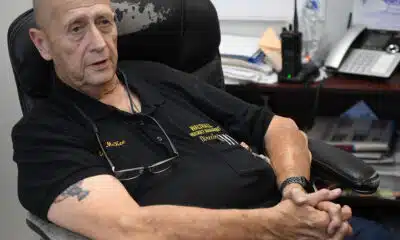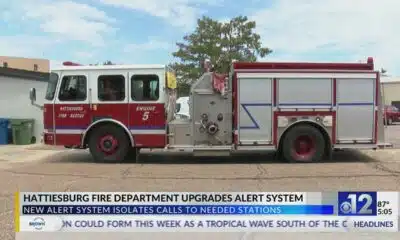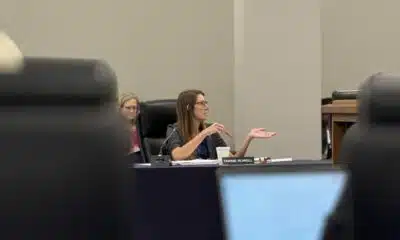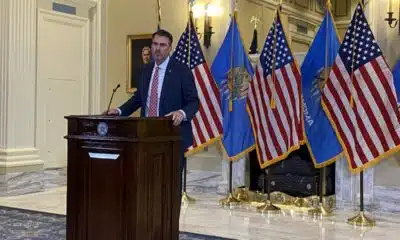Mississippi Today
Troubled south Mississippi man becomes another casualty in rising number of jail suicides
Troubled south Mississippi man becomes another casualty in rising number of jail suicides
Almost a year has passed since Harlene Blair of McHenry last saw her 21-year-old son Eli Marrero, alive. Now she wonders if she’ll ever find out why he died in law enforcement custody.
Blair told MCIR she was told her son was found hanging from a light fixture in his solitary confinement cell in the Stone County Correctional Facility on Jan. 29, 2022 — five months before his 22nd birthday.
Blair said her son’s case hasn’t gotten the attention it deserves from the investigators or the media. “I’m kind of afraid the police will mess with me if my name is printed, but I don’t care. I’ve called everybody from the TV stations and the newspapers all the way to the governor,” Blair said. “I’ve called fifty law firms — all of them said they’d have a conflict of interest since they have to work with police.”
Blair said her son was arrested at her home after Thanksgiving in 2021 for not reporting to his probation officer in relation to stealing a car. Blair said the car belonged to Marrero’s cousin, and Marrero’s defense was that he thought he had permission to drive it. Blair said she saw papers Marrero had received after his release, and she saw no mention of needing to report to anyone. She said her questions to the sheriff at his arrest were rebuffed.
“I asked them for the paperwork with the warrant, and they wouldn’t give me anything, and they wouldn’t let me hug him goodbye,” Blair said.
The sheriff would not respond to questions for comment.
Eli Marrero, diagnosed with Schizophrenia when he was 16, was 21 when he was discovered hanging in his Stone County jail cell on Jan. 28, 2022.
Marrero suffered from schizophrenia, diagnosed at age 16. Blair said he received treatment at Gulf Coast Mental Health Center in Wiggins. She said she did not think Marrero was medicated while he was in jail, even though she said she told the sheriff’s department he needed his medication when they came to arrest him. “They sent two cop cars to come get him,” she said.
Attorney David Sullivan of Gulfport, who was Marrero’s public defender on the car theft charge, told MCIR that he didn’t understand why Marrero would have been arrested in the first place for not reporting to his probation officer. He said that in cases like that, police usually arrest a person as they encounter them in the community — not going out of their way to find him at home.
And even if he were sentenced on the charge, Marrero might have been credited with time served or even have gotten a second chance from the judge, Sullivan said. “He wasn’t looking at years in prison. He did that time because he couldn’t afford to bond out. He would have been parole-eligible anyway.”
He said Marrero was not entitled to a public defender for a probation violation charge so he was no longer involved in the young man’s defense.
Jail suicides on the rise
Jail suicides are becoming more common — 340 persons in state and federal prisons and 355 in local jails died by suicide in 2019, based on the most recent mortality data from the Bureau of Justice Statistics. The number of suicides in local jails increased 5% from 2018 to 2019, while suicides in state and federal prisons remained stable.
Suicides accounted for almost a third of deaths in local jails and 8% of deaths in state and federal prisons in 2019, according to the BJS. Nearly a fifth of the nation’s 1,161 state and federal prisons and a tenth of the 2,845 local jails had at least one suicide in 2019.
Over the 20-year period from 2000 to 2019, more than 6,200 local jail inmates died by suicide while in custody. Suicide deaths among jail inmates increased 13% over the period. Those who died by suicide were most often male, non-Hispanic white, incarcerated for a violent crime and died by self-strangulation.
More than three-quarters of jail inmates who died by suicide from 2000 to 2019 had not been convicted and were awaiting adjudication of their charge, according to the report.
The Mississippi Department of Mental Health is trying to get a handle on just how many prisoners in jails are battling mental illness, said Dr. Tom Recore, the head of forensic services for Mississippi since April 2022.
The department recently completed a year-long longitudinal study of just how long it takes for a mentally ill inmate to be ordered to have a competency hearing. The figures were stunning: inmates spent an average of 555 days in jail from the alleged offense until a judge ordered they be evaluated to see if they were competent to stand trial.
“The averages are high because of a handful of counties,” Recore explained.
Once the order was sent, it typically took another 191 days to process an inmate through a competency hearing, an evaluation period, and an order of noncompetency being entered. That amounted to 748 days — a little more than two years — according to the study.
Some of those inmates had been indicted for their crimes, and some had not — depending on when their cases were presented to a grand jury, which is the responsibility of the county, Recore noted.
One of the reasons that the first waiting period is so long is the inmates’ attorneys typically have to request a competency hearing, and Mississippi does not have a full-time public defender system in place. In Stone County, most public defenders are private attorneys from the Coast who do the work for $500 per inmate, Sullivan noted.
The Office of the State Public Defender was established in 2011 to unite various state agencies providing public defense under one umbrella and to develop proposals for a statewide public defender system. It issued its final report in 2018 to the Legislature, outlining a proposal for a statewide public defender system. The office’s annual report in 2021 shows that implementation of the proposals is not complete, with the office proposing three pilot programs, one in each Supreme Court district, to be presented to the Legislature next year.
House Bill 360 to provide funding for these pilot programs passed the House in 2022 and died in the Senate Judiciary B Committee on March 1, 2022, according to the bill status website. The OPD's 2022 annual report noted that efforts will be made to pass this pilot program in 2023.
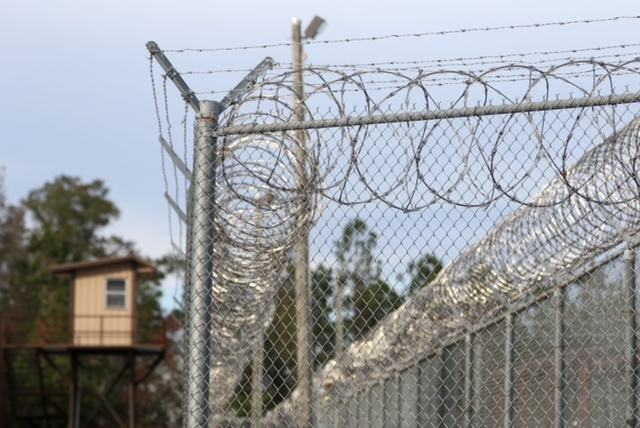
A troubled man and problematic inmate
The Mississippi Bureau of Investigation, which has oversight over inmate deaths in the state, is investigating Marrero’s death. Because the investigation is ongoing, records of the case are unavailable under the state’s Open Records Act, according to Robert E. Wentworth, staff officer in Mississippi Department of Public Safety’s legal division.
But arrest records and incident reports obtained by MCIR paint a picture of a troubled man who became a problematic inmate.
According to his Dec. 2, 2021, interview, Marrero told booking officer Vickie Clark that he suffered from mental illness but did not receive treatment for it. He also said he had received treatment for substance abuse in the past, although it was not clear from those records where he received such treatment. His brief mental status exam at that time was deemed within normal limits.
During previous jail stays, Marrero had other incident reports — once for attempting to exit the jail through the fire escape door on the bay back to his lockdown cell after a court date in April 2021. Cpl. Aaron Lumpkin noted Marrero said God told him to go outside instead of to his cell. Attempts to get him into his cell resulted in an altercation between Lumpkin and Marrero, with two correctional officers assisting Lumpkin in getting Marrero into cell 135A, noted on Marrero’s transfer papers as a “suicide cell.”
Less than a month later, Marrero was the center of a multiple-inmate verbal altercation where other offenders accused Marrero of using racial slurs and of walking in on them during showers. As a result, Marrero was placed on lockdown without contact with any other prisoners, per Lumpkin’s report on the incident, or his mother.
On July 29, 2021, Marrero flooded his cell and other areas of the jail with “toilet water,” according to the report. He would not leave his cell when told to do so, resulting in Capt. Eddie Rogers, chief of security at Stone County Correctional Facility, spraying him with a one-second burst of pepper spray and a brief scuffle between them to get Marrero out of his cell, with six other officers in attendance, according to Lumpkin’s incident report.
Marrero lashed out at a particular inmate during his jail stays, identified in the records as Octavian Stanley — first on July 20, 2021, with the two shouting threats at each other, then, according to an affidavit filed on Dec. 29, 2021, alleging Marrero had jumped Stanley from behind and hit him in the head. An incident report from that day corroborates that Marrero had attacked Stanley while the inmate was cuffed. The scuffle resulted in a decision that the two should not be out of their cells at the same time for any reason.
Three days before his death on Jan. 25, 2022, Marrero was also written up for attempting to assault an officer. The officer noted that Marrero swung his handcuffed fists at the officer’s face. The officer blocked his swing and shoved him into his cell. According to the incident report, two other correctional officers witnessed the assault.
Blair confirmed Marrero, as a teenager, stayed in trouble at school because of problems with attention deficit disorder and got his GED after dropping out.
An April 24, 2017, article in the Biloxi Sun Herald quotes Capt. Ray Boggs as saying Marrero escaped from youth court after a hearing, possibly running off with his girlfriend who had a car waiting outside the building, injuring Chief Deputy Phyllis Olds.
‘This is not the place they need to be’
Marrero’s autopsy dated Feb. 1, 2022, which MCIR obtained from Blair, was signed by State Medical Examiner Dr. Staci Turner. It found ligature markings on Marrero’s neck, partially encircling it, which the examiner found consistent with the history given that Marrero had been found hanging in his cell. No spinal cord injury was present, nor was there any substances found in his body per the toxicology report. All other organs were normal with no evidence of natural disease.
Stone County Coroner Wayne Flurry said he was called to Memorial Hospital in Stone County, where Marrero had been taken in an effort to revive him. Flurry said he was told Marrero had been found hanging from a light fixture in his cell. Since Marrero had died in jail, the case was referred to MBI to investigate, and Marrero’s body was sent to the state Crime Lab for autopsy. “I referred it to the State Medical Examiner because all I had to go on was what I had been told,” Flurry said. “I did not go to the jail.”
Marrero’s case is not the first time Stone County Sheriff’s Department has been investigated for how it handled the mentally ill. In June 2019, Pablo de la Cruz, then a sheriff’s K-9 deputy, resigned amid an investigation into the alleged mistreatment of a mentally ill man picked up on a court order related to his health.
Blair said not knowing what exactly happened to her son was the most difficult part about his death. “Nobody would tell me anything,” she said. “Every time I asked why he was in solitary confinement, they said he’s not fit for general population.”
Rogers said it was known throughout the jail and the community that Marrero had problems. “One minute he was fine, the next minute you were like, what are you even saying? It would sound like he was speaking in Arabic,” Rogers said.
“It’s a sad situation,” Rogers said. “This is not the place they need to be. But I don't know if Mississippi is ever going to do anything about it.”
Recore said the state is attempting to build a new system of services that quickly identifies mentally ill individuals in the prison system, gets them evaluated for competency, and gets them the necessary treatment they need to be restored to competency if possible — or kept in the least restrictive environment available if that’s not possible.
Blair said she feels like some simple measures could have kept her son alive. “I would like them to take the bedsheets out of solitary confinement and to keep a better eye on the people in there,” she said, noting her son should have been checked on every 30 minutes or so if he was at risk for suicide.
Wendy Bailey, executive director at the Department of Mental Health, said the state is attempting to provide a continuum of care with two pilot programs based out of Region 8 Mental Health in Brandon and Region 12 Pine Belt Mental Health to connect inmates with medical treatment earlier in their confinement.
She said anyone who is concerned with the mental health of inmates should familiarize themselves with these new programs. “If you have everybody at the table, all the advocates for care, we can create a system that Mississippi can be proud of,” Bailey said.
This story was produced by the Mississippi Center for Investigative Reporting, a nonprofit news organization that is exposing wrongdoing, educating and empowering Mississippians, and raising up the next generation of investigative reporters. Sign up for our newsletter.
Email Julie Whitehead at julie.whitehead.mcir@gmail.com.
This article first appeared on Mississippi Today and is republished here under a Creative Commons license.
Did you miss our previous article…
https://www.biloxinewsevents.com/?p=197664
Mississippi Today
Presidents are taking longer to declare major natural disasters. For some, the wait is agonizing
TYLERTOWN — As an ominous storm approached Buddy Anthony’s one-story brick home, he took shelter in his new Ford F-250 pickup parked under a nearby carport.
Seconds later, a tornado tore apart Anthony’s home and damaged the truck while lifting it partly in the air. Anthony emerged unhurt. But he had to replace his vehicle with a used truck that became his home while waiting for President Donald Trump to issue a major disaster declaration so that federal money would be freed for individuals reeling from loss. That took weeks.
“You wake up in the truck and look out the windshield and see nothing. That’s hard. That’s hard to swallow,” Anthony said.
Disaster survivors are having to wait longer to get aid from the federal government, according to a new Associated Press analysis of decades of data. On average, it took less than two weeks for a governor’s request for a presidential disaster declaration to be granted in the 1990s and early 2000s. That rose to about three weeks during the past decade under presidents from both major parties. It’s taking more than a month, on average, during Trump’s current term, the AP found.
The delays mean individuals must wait to receive federal aid for daily living expenses, temporary lodging and home repairs. Delays in disaster declarations also can hamper recovery efforts by local officials uncertain whether they will receive federal reimbursement for cleaning up debris and rebuilding infrastructure. The AP collaborated with Mississippi Today and Mississippi Free Press on the effects of these delays for this report.
“The message that I get in the delay, particularly for the individual assistance, is that the federal government has turned its back on its own people,” said Bob Griffin, dean of the College of Emergency Preparedness, Homeland Security and Cybersecurity at the University at Albany in New York. “It’s a fundamental shift in the position of this country.”
The wait for disaster aid has grown as Trump remakes government
The Federal Emergency Management Agency often consults immediately with communities to coordinate their initial disaster response. But direct payments to individuals, nonprofits and local governments must wait for a major disaster declaration from the president, who first must receive a request from a state, territory or tribe. Major disaster declarations are intended only for the most damaging events that are beyond the resources of states and local governments.
Trump has approved more than two dozen major disaster declarations since taking office in January, with an average wait of almost 34 days after a request. That ranged from a one-day turnaround after July’s deadly flash flooding in Texas to a 67-day wait after a request for aid because of a Michigan ice storm. The average wait is up from a 24-day delay during his first term and is nearly four times as long as the average for former Republican President George H.W. Bush, whose term from 1989-1993 coincided with the implementation of a new federal law setting parameters for disaster determinations.
The delays have grown over time, regardless of the party in power. Former Democratic President Joe Biden, in his last year in office, averaged 26 days to declare major disasters — longer than any year under former Democratic President Barack Obama.

FEMA did not respond to the AP’s questions about what factors are contributing to the trend.
Others familiar with FEMA noted that its process for assessing and documenting natural disasters has become more complex over time. Disasters have also become more frequent and intense because of climate change, which is mostly caused by the burning of fuels such as gas, coal and oil.
The wait for disaster declarations has spiked as Trump’s administration undertakes an ambitious makeover of the federal government that has shed thousands of workers and reexamined the role of FEMA. A recently published letter from current and former FEMA employees warned the cuts could become debilitating if faced with a large-enough disaster. The letter also lamented that the Trump administration has stopped maintaining or removed long-term planning tools focused on extreme weather and disasters.
Shortly after taking office, Trump floated the idea of “getting rid” of FEMA, asserting: “It’s very bureaucratic, and it’s very slow.”
FEMA’s acting chief suggested more recently that states should shoulder more responsibility for disaster recovery, though FEMA thus far has continued to cover three-fourths of the costs of public assistance to local governments, as required under federal law. FEMA pays the full cost of its individual assistance.
Former FEMA Administrator Pete Gaynor, who served during Trump’s first term, said the delay in issuing major disaster declarations likely is related to a renewed focus on making sure the federal government isn’t paying for things state and local governments could handle.
“I think they’re probably giving those requests more scrutiny,” Gaynor said. “And I think it’s probably the right thing to do, because I think the (disaster) declaration process has become the ‘easy button’ for states.”
The Associated Press on Monday received a statement from White House spokeswoman Abigail Jackson in response to a question about why it is taking longer to issue major natural disaster declarations:
“President Trump provides a more thorough review of disaster declaration requests than any Administration has before him. Gone are the days of rubber stamping FEMA recommendations – that’s not a bug, that’s a feature. Under prior Administrations, FEMA’s outsized role created a bloated bureaucracy that disincentivized state investment in their own resilience. President Trump is committed to right-sizing the Federal government while empowering state and local governments by enabling them to better understand, plan for, and ultimately address the needs of their citizens. The Trump Administration has expeditiously provided assistance to disasters while ensuring taxpayer dollars are spent wisely to supplement state actions, not replace them.”

In Mississippi, frustration festered during wait for aid
The tornado that struck Anthony’s home in rural Tylertown on March 15 packed winds up to 140 mph. It was part of a powerful system that wrecked homes, businesses and lives across multiple states.
Mississippi’s governor requested a federal disaster declaration on April 1. Trump granted that request 50 days later, on May 21, while approving aid for both individuals and public entities.
On that same day, Trump also approved eight other major disaster declarations for storms, floods or fires in seven other states. In most cases, more than a month had passed since the request and about two months since the date of those disasters.
If a presidential declaration and federal money had come sooner, Anthony said he wouldn’t have needed to spend weeks sleeping in a truck before he could afford to rent the trailer where he is now living. His house was uninsured, Anthony said, and FEMA eventually gave him $30,000.
In nearby Jayess in Lawrence County, Dana Grimes had insurance but not enough to cover the full value of her damaged home. After the eventual federal declaration, Grimes said FEMA provided about $750 for emergency expenses, but she is now waiting for the agency to determine whether she can receive more.

“We couldn’t figure out why the president took so long to help people in this country,” Grimes said. “I just want to tie up strings and move on. But FEMA — I’m still fooling with FEMA.”
Jonathan Young said he gave up on applying for FEMA aid after the Tylertown tornado killed his 7-year-old son and destroyed their home. The process seemed too difficult, and federal officials wanted paperwork he didn’t have, Young said. He made ends meet by working for those cleaning up from the storm.
“It’s a therapy for me,” Young said, “to pick up the debris that took my son away from me.”
Historically, presidential disaster declarations containing individual assistance have been approved more quickly than those providing assistance only to public entities, according to the AP’s analysis. That remains the case under Trump, though declarations for both types are taking longer.
About half the major disaster declarations approved by Trump this year have included individual assistance.
Some people whose homes are damaged turn to shelters hosted by churches or local nonprofit organizations in the initial chaotic days after a disaster. Others stay with friends or family or go to a hotel, if they can afford it.
But some insist on staying in damaged homes, even if they are unsafe, said Chris Smith, who administered FEMA’s individual assistance division under three presidents from 2015-2022. If homes aren’t repaired properly, mold can grow, compounding the recovery challenges.

That’s why it’s critical for FEMA’s individual assistance to get approved quickly — ideally, within two weeks of a disaster, said Smith, who’s now a disaster consultant for governments and companies.
“You want to keep the people where they are living. You want to ensure those communities are going to continue to be viable and recover,” Smith said. “And the earlier that individual assistance can be delivered … the earlier recovery can start.”
In the periods waiting for declarations, the pressure falls on local officials and volunteers to care for victims and distribute supplies.
In Walthall County, where Tylertown is, insurance agent Les Lampton remembered watching the weather news as the first tornado missed his house by just an eighth of a mile. Lampton, who moonlights as a volunteer firefighter, navigated the collapsed trees in his yard and jumped into action. About 45 minutes later, the second tornado hit just a mile away.
“It was just chaos from there on out,” Lampton said.
Walthall County, with a population of about 14,000, hasn’t had a working tornado siren in about 30 years, Lampton said. He added there isn’t a public safe room in the area, although a lot of residents have ones in their home.
Rural areas with limited resources are hit hard by delays in receiving funds through FEMA’s public assistance program, which, unlike individual assistance, only reimburses local entities after their bills are paid. Long waits can stoke uncertainty and lead cost-conscious local officials to pause or scale-back their recovery efforts.

In Walthall County, officials initially spent about $700,000 cleaning up debris, then suspended the cleanup for more than a month because they couldn’t afford to spend more without assurance they would receive federal reimbursement, said county emergency manager Royce McKee. Meanwhile, rubble from splintered trees and shattered homes remained piled along the roadside, creating unsafe obstacles for motorists and habitat for snakes and rodents.
When it received the federal declaration, Walthall County took out a multimillion-dollar loan to pay contractors to resume the cleanup.
“We’re going to pay interest and pay that money back until FEMA pays us,” said Byran Martin, an elected county supervisor. “We’re hopeful that we’ll get some money by the first of the year, but people are telling us that it could be [longer].”
Lampton, who took after his father when he joined the volunteer firefighters 40 years ago, lauded the support of outside groups such as Cajun Navy, Eight Days of Hope, Samaritan’s Purse and others. That’s not to mention the neighbors who brought their own skid steers and power saws to help clear trees and other debris, he added.
“That’s the only thing that got us through this storm, neighbors helping neighbors,” Lampton said. “If we waited on the government, we were going to be in bad shape.”
Lieb reported from Jefferson City, Missouri, and Wildeman from Hartford, Connecticut.
Update 98/25: This story has been updated to include a White House statement released after publication.
This article first appeared on Mississippi Today and is republished here under a Creative Commons Attribution-NoDerivatives 4.0 International License.
The post Presidents are taking longer to declare major natural disasters. For some, the wait is agonizing appeared first on mississippitoday.org
Note: The following A.I. based commentary is not part of the original article, reproduced above, but is offered in the hopes that it will promote greater media literacy and critical thinking, by making any potential bias more visible to the reader –Staff Editor.
Political Bias Rating: Center-Left
This article presents a critical view of the Trump administration’s handling of disaster declarations, highlighting delays and their negative impacts on affected individuals and communities. It emphasizes concerns about government downsizing and reduced federal support, themes often associated with center-left perspectives that favor robust government intervention and social safety nets. However, it also includes statements from Trump administration officials defending their approach, providing some balance. Overall, the tone and framing lean slightly left of center without being overtly partisan.
Mississippi Today
Northeast Mississippi speaker and worm farmer played key role in Coast recovery after Hurricane Katrina
The 20th anniversary of Hurricane Katrina slamming the Mississippi Gulf Coast has come and gone, rightfully garnering considerable media attention.
But still undercovered in the 20th anniversary saga of the storm that made landfall on Aug. 29, 2005, and caused unprecedented destruction is the role that a worm farmer from northeast Mississippi played in helping to revitalize the Coast.
House Speaker Billy McCoy, who died in 2019, was a worm farmer from the Prentiss, not Alcorn County, side of Rienzi — about as far away from the Gulf Coast as one could be in Mississippi.
McCoy grew other crops, but a staple of his operations was worm farming.
Early after the storm, the House speaker made a point of touring the Coast and visiting as many of the House members who lived on the Coast as he could to check on them.
But it was his action in the forum he loved the most — the Mississippi House — that is credited with being key to the Coast’s recovery.
Gov. Haley Barbour had called a special session about a month after the storm to take up multiple issues related to Katrina and the Gulf Coast’s survival and revitalization. The issue that received the most attention was Barbour’s proposal to remove the requirement that the casinos on the Coast be floating in the Mississippi Sound.
Katrina wreaked havoc on the floating casinos, and many operators said they would not rebuild if their casinos had to be in the Gulf waters. That was a crucial issue since the casinos were a major economic engine on the Coast, employing an estimated 30,000 in direct and indirect jobs.
It is difficult to fathom now the controversy surrounding Barbour’s proposal to allow the casinos to locate on land next to the water. Mississippi’s casino industry that was birthed with the early 1990s legislation was still new and controversial.
Various religious groups and others had continued to fight and oppose the casino industry and had made opposition to the expansion of gambling a priority.
Opposition to casinos and expansion of casinos was believed to be especially strong in rural areas, like those found in McCoy’s beloved northeast Mississippi. It was many of those rural areas that were the homes to rural white Democrats — now all but extinct in the Legislature but at the time still a force in the House.
So, voting in favor of casino expansion had the potential of being costly for what was McCoy’s base of power: the rural white Democrats.
Couple that with the fact that the Democratic-controlled House had been at odds with the Republican Barbour on multiple issues ranging from education funding to health care since Barbour was inaugurated in January 2004.
Barbour set records for the number of special sessions called by the governor. Those special sessions often were called to try to force the Democratic-controlled House to pass legislation it killed during the regular session.
The September 2005 special session was Barbour’s fifth of the year. For context, current Gov. Tate Reeves has called four in his nearly six years as governor.
There was little reason to expect McCoy to do Barbour’s bidding and lead the effort in the Legislature to pass his most controversial proposal: expanding casino gambling.
But when Barbour ally Lt. Gov. Amy Tuck, who presided over the Senate, refused to take up the controversial bill, Barbour was forced to turn to McCoy.
The former governor wrote about the circumstances in an essay he penned on the 20th anniversary of Hurricane Katrina for Mississippi Today Ideas.
“The Senate leadership, all Republicans, did not want to go first in passing the onshore casino law,” Barbour wrote. “So, I had to ask Speaker McCoy to allow it to come to the House floor and pass. He realized he should put the Coast and the state’s interests first. He did so, and the bill passed 61-53, with McCoy voting no.
“I will always admire Speaker McCoy, often my nemesis, for his integrity in putting the state first.”
Incidentally, former Rep. Bill Miles of Fulton, also in northeast Mississippi, was tasked by McCoy with counting, not whipping votes, to see if there was enough support in the House to pass the proposal. Not soon before the key vote, Miles said years later, he went to McCoy and told him there were more than enough votes to pass the legislation so he was voting no and broached the idea of the speaker also voting no.
It is likely that McCoy would have voted for the bill if his vote was needed.
Despite his no vote, the Biloxi Sun Herald newspaper ran a large photo of McCoy and hailed the Rienzi worm farmer as a hero for the Mississippi Gulf Coast.
This article first appeared on Mississippi Today and is republished here under a Creative Commons Attribution-NoDerivatives 4.0 International License.
The post Northeast Mississippi speaker and worm farmer played key role in Coast recovery after Hurricane Katrina appeared first on mississippitoday.org
Note: The following A.I. based commentary is not part of the original article, reproduced above, but is offered in the hopes that it will promote greater media literacy and critical thinking, by making any potential bias more visible to the reader –Staff Editor.
Political Bias Rating: Centrist
The article presents a factual and balanced account of the political dynamics surrounding Hurricane Katrina recovery efforts in Mississippi, focusing on bipartisan cooperation between Democratic and Republican leaders. It highlights the complexities of legislative decisions without overtly favoring one party or ideology, reflecting a neutral and informative tone typical of centrist reporting.
Mississippi Today
PSC moves toward placing Holly Springs utility into receivership
NEW ALBANY — After five hours in a courtroom where attendees struggled to find standing room, the Mississippi Public Service Commission voted to petition a judge to put the Holly Springs Utility Department into a receivership.
The PSC held the hearing Thursday about a half hour drive west from Holly Springs in New Albany, known as “The Fair and Friendly City.” Throughout the proceedings, members of the PSC, its consultants and Holly Springs officials emphasized there was no precedent for what was going on.
The city of Holly Springs has provided electricity through a contract with the Tennessee Valley Authority since 1935. It serves about 12,000 customers, most of whom live outside the city limits. While current and past city officials say the utility’s issues are a result of financial negligence over many years, the service failures hit a boiling point during a 2023 ice storm where customers saw outages that lasted roughly two weeks as well as power surges that broke their appliances.
Those living in the service area say those issues still occur periodically, in addition to infrequent and inaccurate billing.
“I moved to Marshall County in 2020 as a place for retirement for my husband and I, and it’s been a nightmare for five years,” customer Monica Wright told the PSC at Thursday’s hearing. “We’ve replaced every electronic device we own, every appliance, our well pump and our septic pumps. It has financially broke us.
“We’re living on prayers and promises, and we need your help today.”

Another customer, Roscoe Sitgger of Michigan City, said he recently received a series of monthly bills between $500 and $600.
Following a scathing July report by Silverpoint Consulting that found Holly Springs is “incapable” of running the utility, the three-member PSC voted unanimously on Thursday to determine the city isn’t providing “reasonably adequate service” to its customers. That language comes from a 2024 state bill that gave the commission authority to investigate the utility.
The bill gives a pathway for temporarily removing the utility’s control from the city, allowing the PSC to petition a chancery judge to place the department into the hands of a third party. The PSC voted unanimously to do just that.

Thursday’s hearing gave the commission its first chance to direct official questions at Holly Springs representatives. Newly elected Mayor Charles Terry, utility General Manager Wayne Jones and City Attorney John Keith Perry fielded an array of criticism from the PSC. In his rebuttal, Perry suggested that any solution — whether a receivership or selling the utility — would take time to implement, and requested 24 months for the city to make incremental improvements. Audience members shouted, “No!” as Perry spoke.
“We are in a crisis now,” responded Northern District Public Service Commissioner Chris Brown. “To try to turn the corner in incremental steps is going to be almost impossible.”

It’s unclear how much it would cost to fix the department’s long list of ailments. In 2023, TVPPA — a nonprofit that represents TVA’s local partners — estimated Holly Springs needs over $10 million just to restore its rights-of-way, and as much as $15 million to fix its substations. The department owes another $10 million in debt to TVA as well as its contractors, Brown said.
“The city is holding back the growth of the county,” said Republican Sen. Neil Whaley of Potts Camp, who passionately criticized the Holly Springs officials sitting a few feet away. “You’ve got to do better, you’ve got to realize you’re holding these people hostage, and it’s not right and it’s not fair… They are being represented by people who do not care about them as long as the bill is paid.”
In determining next steps, Silverpoint Principal Stephanie Vavro told the PSC it may be hard to find someone willing to serve as receiver for the utility department, make significant investments and then hand the keys back to the city. The 2024 bill, Vavro said, doesn’t limit options to a receivership, and alternatives could include condemning the utility or finding a nearby utility to buy the service area.

Answering questions from Central District Public Service Commissioner De’Keither Stamps, Vavro said it’s unclear how much the department is worth, adding an engineer’s study would be needed to come up with a number.
Terry, who reminded the PSC he’s only been Holly Springs’ mayor for just over 60 days, said there’s no way the city can afford the repair costs on its own. The city’s median income is about $47,000, roughly $8,000 less than the state’s as a whole.
This article first appeared on Mississippi Today and is republished here under a Creative Commons Attribution-NoDerivatives 4.0 International License.
The post PSC moves toward placing Holly Springs utility into receivership appeared first on mississippitoday.org
Note: The following A.I. based commentary is not part of the original article, reproduced above, but is offered in the hopes that it will promote greater media literacy and critical thinking, by making any potential bias more visible to the reader –Staff Editor.
Political Bias Rating: Centrist
This article presents a factual and balanced account of the situation involving the Holly Springs Utility Department and the Mississippi Public Service Commission. It includes perspectives from various stakeholders, such as city officials, residents, and state commissioners, without showing clear favoritism or ideological slant. The focus is on the practical challenges and financial issues faced by the utility, reflecting a neutral stance aimed at informing readers rather than advocating a particular political viewpoint.
-
Mississippi Today6 days ago
Brandon residents want answers, guarantees about data center
-
News from the South - Texas News Feed5 days ago
Texas high school football scores for Thursday, Sept. 4
-
Our Mississippi Home6 days ago
Southern Miss Faculty and Student Contribute to Groundbreaking NOAA-Funded Plastic Cleanup
-
The Conversation6 days ago
AI is transforming weather forecasting − and that could be a game changer for farmers around the world
-
News from the South - Oklahoma News Feed7 days ago
Family sues Roblox, accusing them of failing to protect kids from predators
-
Mississippi News Video7 days ago
Hattiesburg Fire Department to implement new alert system
-
News from the South - Arkansas News Feed7 days ago
Arkansas correction division to enter settlement over disability law violations
-
News from the South - Oklahoma News Feed7 days ago
Thousands of State Employees Still Working Remotely














